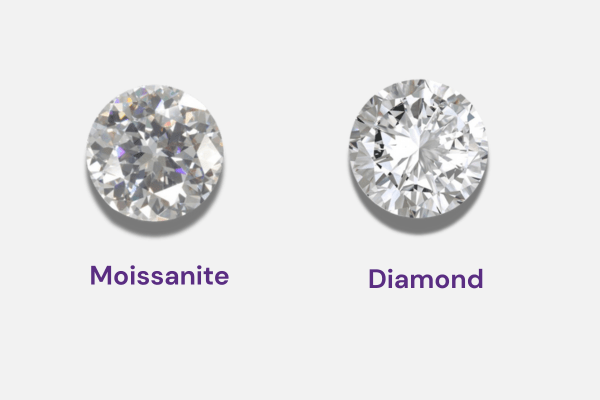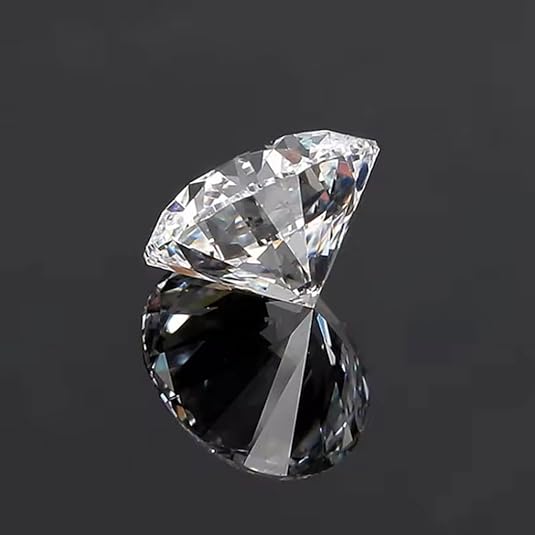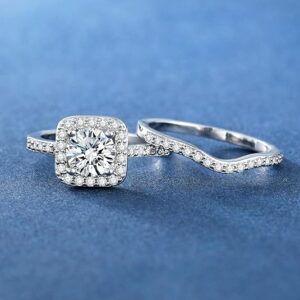Moissanite: (Affordable Diamond Alternative)
Have you ever admired the sparkle of a diamond but wanted something more affordable and ethical? Meet moissanite – a gemstone that shines just as brightly like a diamond, but at a lower price and is made in a lab, so it’s an eco-friendly and guilt-free choice.
Moissanite isn’t just a diamond alternative; it’s a beautiful gem on its own. With its fiery sparkle, durability, and budget-friendly price, it’s quickly becoming a popular choice for engagement rings, wedding bands, and everyday jewelry.
Table of Contents
Why Is Moissanite Gaining Popularity?
Over the past few years, more and more people are choosing moissanite over diamonds. Here’s why:
✓ Looks Like a Diamond (But Sparkles Even More!): Moissanite has more fire and brilliance than diamonds, meaning it catches light beautifully and creates a rainbow-like sparkle.
✓ More Affordable: You can get a larger, high-quality moissanite for a fraction of the price of a diamond.
✓ Ethical & Eco-Friendly: Unlike diamonds, which may come from conflict zones, moissanite is lab-grown—meaning it’s an ethical and environmentally friendly choice.
✓ Super Durable: It ranks 9.25 on the Mohs hardness scale, making it one of the toughest gemstones—perfect for everyday wear.
Is Moissanite a Fake Diamond? (No, It’s Not!)
One of the biggest misconceptions about moissanite is that it’s a “fake diamond.” But let’s get this straight—moissanite is a real gemstone, just like diamonds, sapphires, and rubies.
Here’s the difference:
- A diamond is made of carbon.
- A moissanite is made of silicon carbide.
Both are gemstones, but they have different chemical structures.
The main reason people confuse the two is that moissanite looks very similar to a diamond—but that doesn’t mean it’s a knockoff. It’s simply a different gem with its own special qualities.
Fun Fact: Moissanite was first discovered in a meteorite! Yep, this gem is literally from the stars. ✨

The Origin of Moissanite (A Discovery from Space)
It all started in 1893 when French chemist Henri Moissan found a strange substance in a meteorite crater in Arizona. While studying the meteorite fragments, Moissan discovered what we now call moissanite—a sparkling gemstone that shone as brightly as a diamond.
He was so impressed by its shine that he first thought he had found a diamond. But after more research, he realized it wasn’t a diamond at all. Instead, it was a new material—a silicon carbide crystal, never seen on Earth before.
From Meteorite to Modern Jewelry(The Lab-Created Evolution)
Here’s the twist—while natural moissanite does exist, it’s extremely rare. Only tiny amounts of this gem have been found in meteorites or deep in the Earth’s crust. Today, most moissanite is lab-created. Scientists and jewelers have learned how to make this beautiful gemstone in a controlled setting.
By recreating the conditions Moissan saw in the meteorite, they can now grow perfect moissanite in labs. This process ensures each gemstone is flawless and has that brilliant sparkle people love. The best part? Lab-grown moissanite is more affordable and easier to get than natural gemstones.

Moissanite vs Diamond
Shine and Sparkle
When it comes to sparkle, moissanite doesn’t hold back—it shines even more than diamonds!
Why? It’s because of its higher refractive index. Simply put, this means moissanite bends light more than diamonds do, creating a bright, rainbow-like sparkle. In fact, it can be up to 2.4 times more brilliant than a diamond!
If you love colorful flashes of light in a gemstone, moissanite is a perfect choice. When light hits it, you’ll see a stunning, vibrant shine that’s sure to catch everyone’s attention.
Hardness and Durability
If you’re choosing between a diamond and moissanite, hardness and durability are likely at the top of your mind.
- Diamond is the hardest natural material on Earth, rated 10 on the Mohs scale of hardness.
- Moissanite is a close second, rated 9.25.
Diamonds are the hardest gemstone, but moissanite is also very strong, making it great for everyday wear. In fact, moissanite is less likely to chip or scratch than many other gemstones. This means you can wear it in your engagement ring or other jewelry without worrying about damage.
Color and Clarity
Moissanite and diamonds come in different colors and levels of clarity, but there are some key differences.
- Moissanite’s Color: Moissanite is mostly colorless or nearly colorless, but some stones may have a slight yellow or gray tint, depending on their quality.
- Diamond’s Color: Diamonds are graded from D (completely colorless) to Z (light yellow). High-grade diamonds (D-F) are clear, while lower-grade ones may have a yellow or brown tint.
When it comes to clarity, both gems can have tiny flaws called inclusions. However, moissanite is usually clearer because it is made in a lab, where it is easier to control its purity.

Price Comparison
One of the best things about moissanite is its price.
- Diamonds are rare and expensive, and their cost depends on size, color, clarity, and cut.
- Moissanite, however, is much more affordable, especially if you want a bigger or better-quality stone.
For example, a 1-carat moissanite might cost around $500-$600, while a diamond of the same size can cost thousands. This means you can get a larger or higher-quality moissanite for the same price as a small diamond.
Ethical and Environmental Impact
Another important thing to think about when comparing moissanite and diamonds is their impact on the environment and ethics.
- Moissanite is made in a lab, so it’s created in a sustainable way with little harm to the environment. It’s also conflict-free since no mining is needed.
- Diamonds, while some come from ethical sources, can sometimes be linked to harmful mining and conflict areas (known as “blood diamonds”).
Choosing moissanite instead of diamonds is a great way to make a responsible choice without losing beauty or quality.

Pros and Cons of Choosing Moissanite: Is It Right for You?
Pros
✓ Ethical & Sustainable: Moissanite is lab-grown, meaning no mining and no harm to the environment. It’s a great choice for eco-conscious buyers.
✓ More Affordable: It costs up to 90% less than diamonds, allowing you to get a bigger, high-quality stone without overspending.
✓ Durable & Long-Lasting: With a 9.25 Mohs hardness, moissanite is strong enough for daily wear and resists scratches.
✓ Brilliant Sparkle: Moissanite reflects more colorful light than diamonds, giving it a unique and eye-catching sparkle.
Cons
✗ Different Brilliance: Moissanite’s rainbow sparkle is bolder than a diamond’s subtle shine, which may not suit everyone.
✗ May Show Warmth: Larger moissanite stones can have a slight yellowish tint, especially in lower grades.
✗ Lower Resale Value: Unlike diamonds, moissanite doesn’t hold much resale value due to its availability.

Frequently Asked Question's
Moissanite is made of silicon carbide (SiC), a combination of silicon and carbon. This gives it its amazing sparkle and strength, making it a great choice for jewelry.
Great question!
The answer lies in the production process. While diamonds are rare and take billions of years to form deep within the Earth, moissanite is created in labs using advanced technology, making it more affordable and available.
Here’s the million-dollar question: The answer is not easily—and often, the difference isn’t noticeable to the naked eye!In fact, if you were to wear a moissanite ring next to a diamond ring, the average person wouldn’t be able to tell the difference.
Synthetic moissanite is lab-grown moissanite. It’s made in a lab using the same material and looks just like natural moissanite, but it’s more eco-friendly and affordable since it’s created without mining.
Moissanite fire is the rainbow-colored sparkle that comes from the gemstone. Because moissanite bends light more than diamonds, it creates bright, colorful flashes, giving it a fiery brilliance that catches everyone’s eye.
D color moissanite is the highest color grade. It’s completely colorless, just like the best diamonds. If you want a clear, pure gemstone with no yellow or brown tint, D color moissanite is the way to go.
Final Thoughts: Why Moissanite Could Be Your Perfect Choice
Moissanite is more than just a diamond alternative—it’s a stunning, ethical, and budget-friendly gemstone that offers unmatched brilliance and durability. Whether you’re looking for an engagement ring, a special gift, or a timeless piece of jewelry, moissanite gives you the sparkle you love without the high price tag or ethical concerns.
What Do You Think?
- Would you choose moissanite over a diamond?
- What matters most to you when choosing a gemstone—brilliance, price, or ethics?



